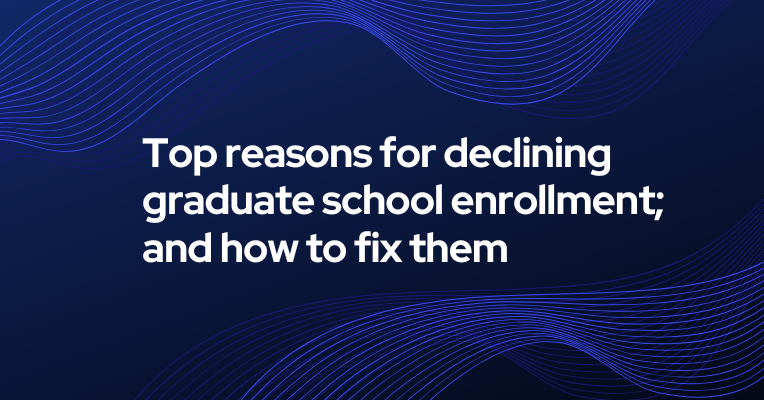In recent years, U.S. colleges and universities have found themselves facing a looming crisis—declining enrollments. The ripple effect of this trend has left many institutions grappling with budget cuts, program reductions, and, in some extreme cases, closures. As prospective students question the value of a college degree and demographic shifts continue to reduce the pool of traditional college-age students, the higher education landscape is rapidly changing.
But what does this mean for institutions? More importantly, what can colleges and universities do to reverse this trend and secure a brighter future? Let’s take a closer look.
The declining enrollment trend: What’s behind it?
Enrollment numbers in U.S. higher education have been steadily declining for the past decade. Between 2010 and 2021, U.S. colleges saw a drop of over 2.7 million students, and the downward trend doesn’t seem to be slowing down anytime soon.
1. Demographic changes
A key factor contributing to this decline is the “demographic cliff.” Lower birth rates have resulted in fewer high school graduates, and this is expected to impact college enrollment numbers for years to come. With a shrinking pool of traditional college-age students, many schools are facing fierce competition just to fill classrooms.
2. Rising costs and student debt
The rising cost of higher education has become a major deterrent for many prospective students. With tuition fees skyrocketing, student loan debt at an all-time high, and little guarantee of a high-paying job after graduation, more students are opting for cheaper or alternative paths—such as vocational training, apprenticeships, or even entering the workforce directly after high school.
3. Changing perceptions of higher education
There’s also a growing sentiment that a four-year degree is no longer the ticket to financial success. As more students question the return on investment of higher education, universities are finding it increasingly difficult to attract new enrollees. It’s not just about affordability—students are looking for clear, practical outcomes tied to their studies.
The consequences for colleges and universities
The effects of declining enrollments are far-reaching. Fewer students mean fewer tuition dollars, which in turn leads to budget cuts, staff layoffs, and potentially the shuttering of certain programs or even entire campuses. Many smaller institutions are particularly vulnerable, as they lack the resources to weather these financial storms.
Institutions with declining enrollment may find themselves in a cycle: as resources become more limited, their appeal to prospective students wanes. This perpetuates the downward trend, making it harder to reverse the situation.
How can colleges respond?
It’s clear that traditional approaches to enrollment management aren’t going to cut it. Colleges need innovative, proactive strategies to turn the tide. Here are a few ways to address the enrollment crisis head-on:
1. Reimagine recruitment efforts
With fewer students applying to college, it’s time for institutions to think outside the box. Develop targeted marketing campaigns that not only highlight academic excellence but also focus on campus culture, job placement rates, and long-term alumni success. Engage potential students earlier in the process and stay connected with them through personalized outreach.
2. Create stronger industry partnerships
Colleges and universities should foster strong relationships with local businesses and industries to create pathways that link education directly to careers. By offering internships, co-op programs, and job placement services that align with industry needs, schools can demonstrate the tangible value of a degree.
3. Focus on financial accessibility
As tuition costs continue to rise, making higher education more affordable through scholarships, financial aid, and flexible payment plans will help ease the burden on students and their families. Schools that invest in financial support systems are more likely to attract a diverse and talented pool of applicants.
4. Leverage technology and CRM systems for engagement
In the digital age, technology is key to keeping prospective students engaged. Personalized communication, automated email campaigns, and data-driven outreach strategies can help increase enrollment rates. This is where an advanced Customer Relationship Management (CRM) system, such as Meritto, can make all the difference.
How Meritto can help graduate schools navigate the crisis
Meritto is a unified, purpose-built CRM designed specifically for higher education institutions, including graduate schools. This innovative platform empowers schools to streamline their recruitment efforts, engage prospective students, and optimize their enrollment strategies. Here’s how Meritto can help:
- AI-Driven insights: Meritto’s data-driven insights allow graduate schools to identify high-potential students early in the recruitment process, enabling targeted outreach and engagement.
- Personalized outreach: With Meritto’s automation tools, graduate schools can send personalized communications at scale, ensuring that prospective students feel valued and connected to the institution.
- Streamlined admissions: Meritto automates the admissions process, reducing administrative burdens and ensuring that no student’s application falls through the cracks.
- Real-time analytics: With Meritto’s real-time analytics, graduate schools can make informed, data-driven decisions to improve their recruitment and enrollment strategies.
Conclusion: Navigating the future of graduate education
While the decline in graduate school enrollments is a real and pressing challenge, it’s not an insurmountable one. By rethinking recruitment strategies, strengthening industry connections, making education more affordable, and leveraging advanced CRM tools like Meritto, graduate schools can adapt to the evolving landscape and secure a sustainable future.
The key to success in this new era of graduate education is adaptability. By embracing these strategies, graduate schools can attract more students, increase enrollment, and ultimately thrive in the face of changing circumstances. Schedule a personalized demo today
- Inside the UAE’s shift toward AI-driven higher education
- Do Educational Organizations need a Sales CRM?
- What’s new at Meritto: The quarterly roundup
- Scaling Universities & Colleges with a Higher Education CRM
- Here’s How CRM Software for Preschool Scales Admissions




